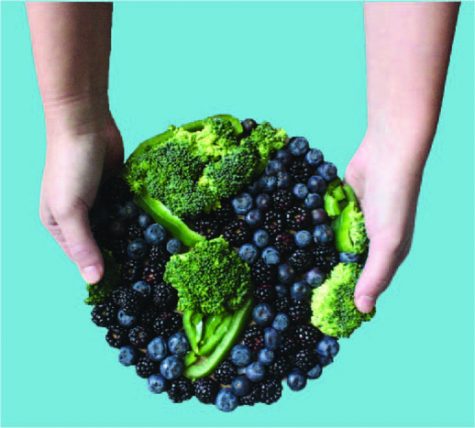Effects of food waste trash the planet

After realizing she disliked the sandwich only a couple bites in, a new meal was bought as quickly as the old one was disposed of. Senior Lauren Holick, one of the presidents of Environmental Awareness Club, was in the cafeteria when her friend came over to her table with a sandwich that was almost immediately thrown into the trash.
“I think … if you have a sandwich crust, you’re not going to be thinking about [wasting],” said Holick. “But if you’re throwing away half of your sandwich, … you know you’re wasting.”
Kai Olson-Sawyer, senior research andpolicy analyst at GRACE Communications Foundation, an environmental group that works on the sustainability of food production and consumption, said in a phone interview that up to 40 percent of food produced in the United States goes uneaten. Dairy products are the most wasted because they spoil easily. After dairy, vegetables are the food groups that are most commonly wasted, followed by fruit and grain products, then meat and poultry.
“It’s enormous waste, and it’s something we need to look out at,” said Olson-Sawyer. “It’s completely unnecessary and kind of careless.”
In a phone interview, James Jennings, waste reduction and compliance section manager for the Illinois Environmental Protection Agency, said a lot of waste occurs because there is no national standard for expiration dates, which causes consumer confusion and contributes to food waste. Dates on packages do not have the same meaning and are not consistent from product to product, so people err on the side of caution and throw out more food.
Katie Sandson, clinical fellow at the Harvard Law School Food Law and Policy Clinic, said in a phone interview that most of the expiration dates are determined based on when food will taste best rather than when it goes bad.
“For the vast majority of food products, they can still be eaten past the date [listed on the packaging] and will be perfectly safe,” Sandson said.
According to Olson-Sawyer, a general rule to see if the food is safe to eat is whether it passes the “smell test” or not.
“If it doesn’t smell like it’s spoiled, it almost definitely [is] not,” Olson-Sawyer said.
Olson-Sawyer said this wasted food also misuses water, fertilizer and cropland required for the production of the food.
“If you’re not valuing [food], you’re also not valuing your water, your land, people’s time and labor,” Olson-Sawyer said.
According to Jennings, landfills have a finite capacity, and this disposed food takes up landfill space which will eventually prevent other waste that has to go in landfills from using that area.
Olson-Sawyer said when food goes into a landfill, it produces greenhouse gas emissions.
“When [food is] packed into a landfill, it doesn’t degrade like it would if it were composted or put in a field,” said Olson-Sawyer. “So it builds up and then releases a lot of methane. So that’s, in total, about 2.6 percent of total U.S. [greenhouse] gas emissions.”
According to Olson-Sawyer, the greenhouse gas emissions that come from wasted food, primarily in the form of methane, are about the same as the emissions of 37 million cars in the United States. Methane traps about 25 times more heat than carbon dioxide, and this can lead to higher average temperatures on Earth.
Sandson said there is a difference between food loss and food waste. Food loss is the food that is lost in early stages of food processing. In contrast, food waste occurs at the consumer and retail stages.
“Here in the U.S., a huge amount of our food waste is at the consumer … level,” said Sandson. “So it’s the food we’re all throwing out in our homes. It’s the food that’s getting thrown out at grocery stores and restaurants.”
Holick said she has realized that nothing else matters if we do not have a planet or a place to call home.
“It’s the fault of everyone.
“But mostly it’s our own fault because we need to … take responsibility,” said Holick. “We can say, ‘Oh, I don’t want to finish that. I’m not entitled to eat that,’ but you have to be conscious about what you’re buying because your waste has an effect on the entire world.”

